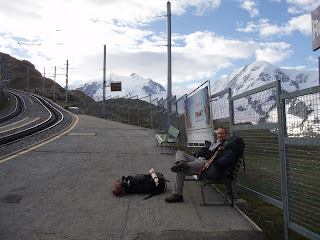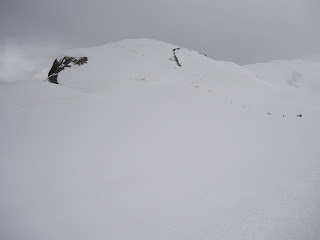The following day, we decided to opt for the 'late' breakfast at 7am and were heading back for civilization by about 9. The return was a bit more interesting, since the lower glacier had begun to weep and I only had one functioning crampon. Apart from a couple of cartoon-esque slips (accompanied by cartoonesque swearing - $%*&), we made it across in one piece and were back at Rotenboden within 3 hours.
We both encountered strange effects over the next few days. For a start, we were sunburnt - therefore we learnt to apply sunscreen and wear sunglasses for ALL of the daylight, not just the sunny bits. Seems obvious, but when there was complete cloud cover, we didn't think about it.
Ben felt a bit nauseous when returning to 1600m in Zermatt 24 hours after finishing the climb and then didn't want to eat anything - just sleep. I found a similar thing when we got to Geneva the next day, 48 hours and not much above sea level. I'm not quite sure what to read into this and it was nothing serious, but it seems the altitude can work both ways. Neither of us got headaches though, or any other problems apart from fatigue when on the mountain.
As far as our equipment was concerned, we took a little food, 2l of water each (too much, but probably would have been right in warmer weather), lots of warm clothes, gloves and hat which we wore most of the time, sunglasses+suncream (which were underused!), 50m rope and harness (30m would easily have been sufficient, but 50m was all we had - we tied double-figure-of-eight knots at 2m intervals to give friction if we fell off anthing), winter boots, crampons and ice axe (obviously essential) and headtorch (for before 5am). No specialist climbing gear or navigation equipment was needed, though I did have a belay plate, guidebook and GPS with me - all went unused.

A view of the upper reaches of Monte Rosa from the Breithorn. Dufourspitze is in the centre and our route follows the white 'S' shape below that.


























